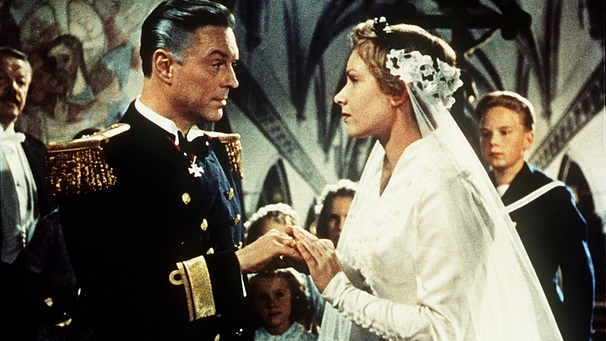Alas, there be no golden nuggets among this batch of films, but some of these movies are mighty entertaining nonetheless.
Can't Help Singing ( 1944 ) 14k
A senator's daughter joins a wagon train en route to California in the hopes of meeting up with the lieutenant she wants to marry. On the way, she falls in love with a card shark. Deanna Durbin, Robert Paige, Akim Tamiroff, Leonid Kinskey, Ray Collins, David Bruce. Universal Pictures. Directed by Frank Ryan.
After making thirteen black-and-white films, the powers-that-be at Universal Studios decided to showcase their number one box-office attraction, Winnipeg's Sweetheart, in her first Technicolor production Can't Help Singing. The film was a great success combining light-hearted comedy and romance with beautiful western locales and some lovely tunes by Jerome Kern ( which were nominated for two Oscars ). A slew of wonderful character actors also appear, including Akim Tamiroff and Leonid Kinskey, who do a great bit of schtick involving Durbin's trunk.
___________________________________________________________
How to Frame a Figg ( 1971 ) 14k
A city accountant gets framed by crooked politicians in a $50,000 swindle and must use the new accounting computer, L.E.O, to help him prove his innocence. Don Knotts, Frank Welker, Joe Flynn, Edward Andrews, Elaine Joyce. Universal Pictures. Directed by Alan Rafkin.
Don Knotts is fun to watch in every movie he made. How to Frame a Figg isn't as memorable as The Ghost and Mr. Chicken or The Reluctant Astronaut but it has its moments...many of them highly amusing. This was the last of a series of comedies that Knotts made for Universal Pictures. Later, he would team up with Tim Conway in such Disney classics as The Apple Dumpling Gang and Hot Lead, Cold Feet. Incidentally, while Frank Welker was great as Hollis' friend Prentiss, Tim Conway would have been an even better addition to the film.
___________________________________________________________
The Man from the Alamo ( 1953 ) 14k.
John Stroud is branded a coward when he leaves the scene of the Alamo to check on his and the other soldiers' families back at their ranches in Ox Bow, but he later gets a chance to prove his courage when he protects a wagon train being attacked by a gang of outlaws. Glenn Ford, Julie Adams, Chill Wills, Victor Jory, Hugh O'Brien. Universal Pictures. Directed by Budd Boetticher.
Throughout the 1950s, Budd Boetticher directed a number of low-budget westerns starring Randolph Scott. The Man from the Alamo could have easily been a Scott western, but instead, it stars the delightful Glenn Ford as the downcast soldier Stroud who is branded a coward. Julie Adams, one of the busiest Western stars of the era, didn't get much of a romantic part in this movie but adds a feminine touch to a very masculine film. Little Marc Cavell is also adorable as Stroud's only friend, Carlos. Overall, it's an entertaining but not very memorable western.
___________________________________________________________
The Unholy Intruders aka Hinter Klostermauern ( 1952 ) 14k.
A middle-aged man returns home from the war and, unable to find lodging for his girlfriend and child, he moves them into an abandoned convent. When the nuns return to occupy it again, he refuses to leave and his presence proves to be a thorn to the nuns. Olga Tschechowa, Philip Dorn, Katharina Mayberg, Dorothea Wieck. Delta-Venus. Directed by Harald Reinl.
Thomas and Kathrin are two protagonists that you instantly want to hate, and it is very difficult for a film to hold the attention of its audience with the presence of anti-heroes. Yet, as Thomas ( Philip Dorn ) is just about to go from bad to worse, he has a change of heart and his redemption becomes the drawing feature of the film. Olga Tschechowa, that legend of the silent era, plays the prioress in this movie with such conviction. At one time Olga was accused of being a Russian agent in Nazi Germany. She obviously knows how to play many parts well!
___________________________________________________________
Anne of Windy Poplars ( 1940 ) 14k
Anne Shirley takes up her first position as vice-principal in the town of Windy Poplars but finds she must first win over hostile faculty and feuding citizens before she receives a welcome. Anne Shirley, James Ellison, Slim Summerville, Henry Travers, Louise Campbell. RKO Pictures. Directed by Jack Hively.
Six years passed before RKO decided to film a sequel to Anne of Green Gables ( 1934 ) which was based on L.M. Montgomery's book series of the same name. Anne Shirley, who portrayed Anne Shirley in the original film, returns to her namesake role, this time playing an older and more mature schoolteacher. The film trots along at a gentle pace and, while it isn't anything special, there are a number of good scenes, especially those involving character actors Slim Summerville and Henry Travers. Poor Anne sure has to put up with a lot of curmudgeons in Windy Poplars, but with her gentle ways she naturally wins them over by the end of the film....and gains a daughter too.

























